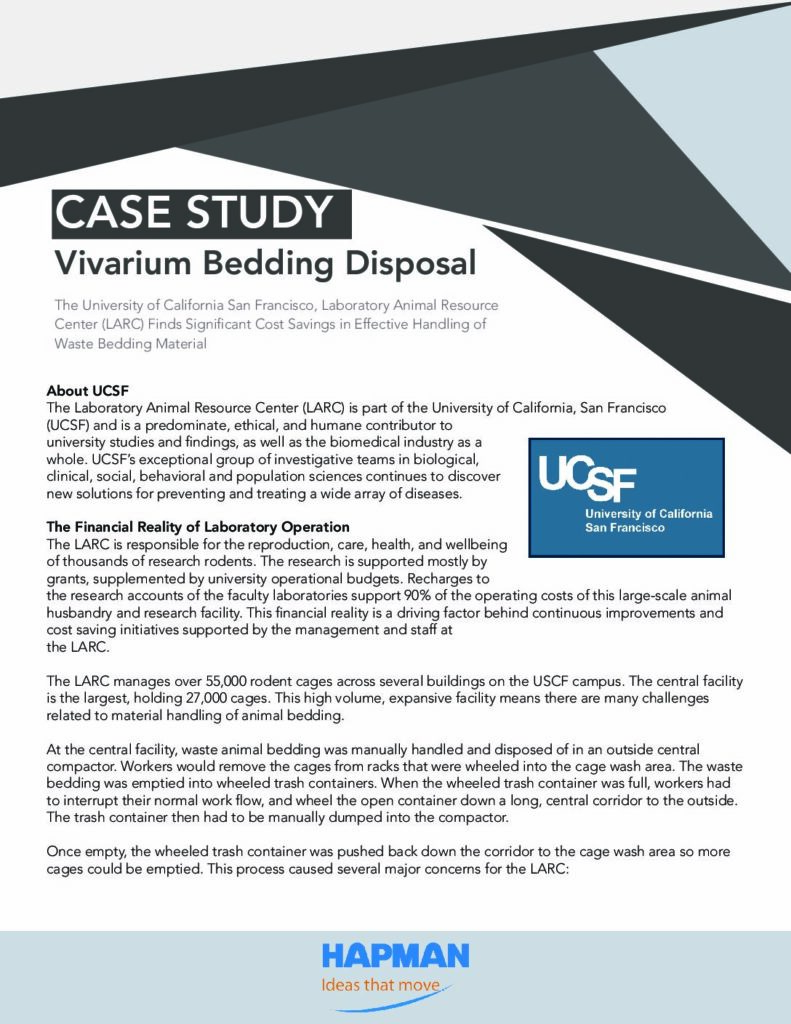
CHALLENGE
The facility, which manages over 55,000 rodent cages, needed a more reliable and cost effective way to dispose of waste bedding, as well as mitigate allergen exposure, and reduce physical injuries to employees due to repetitive lifting, bending and twisting.
CUSTOMER
The Laboratory Animal Resource Center (LARC), part of the University of California, San Francisco (UCSF)
INDUSTRY
University Studies, and Biomedical Industry
BUSINESS BENEFITS REALIZED
– Increased productivity by streamlining workflow.
– Decreased allergen contamination to both workers and animals.
– Reduced costs and maintenance over previous system.
The Laboratory Animal Resource Center (LARC) is part of the University of California, San Francisco (UCSF) and is a predominate, ethical, and humane contributor to university studies and findings, as well as the biomedical industry as a whole. UCSF’s exceptional group of investigative teams in biological, clinical, social, behavioral and population sciences continues to discover new solutions for preventing and treating a wide array of diseases.
THE FINANCIAL REALITY OF LABORATORY OPERATION
The LARC is responsible for the reproduction, care, health, and well- being of thousands of research rodents. The research is supported mostly by grants, supplemented by university operational budgets. Recharges to the research accounts of the faculty laboratories support 90% of the operating costs of this large-scale animal husbandry and research facility. This financial reality is a driving factor behind continuous improvements and cost saving initiatives supported by the management and staff at the LARC.
“MANUAL BEDDING HANDLING IS NOT SAFE FOR WORKERS OR ANIMALS.” – Cliff Roberts, LARC Director
The LARC manages over 55,000 rodent cages across several buildings on the USCF campus. The central facility is the largest, holding 27,000 cages. This high volume, expansive facility means there are many challenges related to material handling of animal bedding.
At the central facility, waste animal bedding was manually handled and disposed of in an outside central compactor. Workers would remove the cages from racks that were wheeled into the cage wash area. The waste bedding was emptied into wheeled trash containers. When the wheeled trash container was full, workers had to interrupt their normal work flow, and wheel the open container down a long, central corridor to the outside. The trash container then had to be manually dumped into the compactor.
Once empty, the wheeled trash container was pushed back down the corridor to the cage wash area so more cages could be emptied. This process caused several major concerns for the LARC:
Interruption of work flow
Each time the trash bins were filled, the workers had to stop the cage cleaning process to empty the wheeled bins in the outside compactor. This took time and focus away from important tasks.
Worker ergonomics
The lifting, bending, and twisting required for the manual cage emptying and dumping was not ergonomically safe for workers.
Allergens exposure
The process of dumping the bedding into the container and wheeling the open container through the corridor left workers and animals susceptible to exposure to allergens.
FINDING A BETTER SOLUTION
Cliff Roberts, Director of the LARC, knew he needed to overcome the material handling challenges that existed in his facility. He also knew not all conveying systems could effectively handle the waste bedding. Roberts explains, “We have vacuum conveying systems in some of our lab buildings. While they can move some types of bedding effectively, where they struggle is with other items that accidentally get entrained in the bedding and put into the conveyor. These items can range from enrichment items, to gloves, or to ID tags”. Cliff and his facilities management team knew they needed to seek a robust, versatile means of conveying animal bedding if they were going to overcome the current material handling concerns and improve the effectiveness of their operations.
While researching the available options, Cliff found the Hapman bedding system. The Hapman waste bedding removal system consists of a cage dump station that feeds a tubular drag conveyor.
The tubular drag technology, invented by Hapman, uses an industrial chain and flight assembly, and a patented auto- tension system to effectively move any type of bedding and miscellaneous materials without fail. The tubular drag runs with a motorized drive pulling the chain assembly through an enclosed tube. The patented auto- tension system keeps the appropriate tension on the chain, accommodating varying loads, objects, and material density thus significantly reducing the need for adjustment. The system is quiet, and engineered to run down long corridors, above drop ceilings, through walls, and around bends. The flexible layout options make the system ideal for Vivariums because of the space considerations, low noise requirements, and minimal maintenance. The cage dump station could be equipped with an optional HEPA filter exhaust, which would help LARC with the allergen concerns. Cliff believed he found the automated bedding handling system he needed.
SAVING MONEY AND IMPROVING OPERATIONS
In 2011, the first of two Hapman waste bedding removal systems was installed at the LARC. The purchase and installation was conducted as part of a facility upgrade and expansion project.
Getting the Hapman system to fit into the project budget was relativity easy. Roberts noted, “The tubular drag waste bedding system was less expensive than the vacuum system, both from a capital cost and operating cost perspective. The fact that the tubular drag conveyor offers less maintenance than our vacuum systems, and less strain and risk to the facility workers over our manual processes, made the decision to purchase the Hapman systems easy.”
The operational process for bedding management improved at the LARC building where the Hapman bedding systems are operating. The workers empty cages into a cage dump station with a filtered exhaust. The cage is then placed on the tunnel wash conveyor while the bedding is automatically moved down the long corridor in a sealed environment. The waste is dumped into the compactor without any strain on the workers or unnecessary exposure.
Productivity has increased and workflow processes improved with the elimination of the manual dumping. Cliff summarizes, “Our goal was to improve operations while also reducing costs. Capital and operating budgets are limited so I needed to be sure the upgrades to our facility were going to pay off. The installations of the Hapman bedding systems have helped us to achieve our operating, improvement, and cost reduction goals.”
For more information on customizable Hapman bedding disposal or bedding feed dispensing systems designed specifically engineered for vivarium applications e-mail sales@hapman.com, or visit www.hapman.com.
